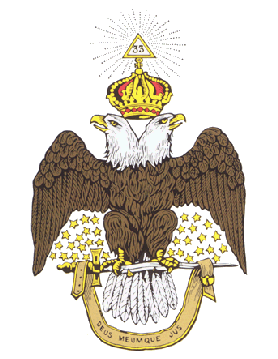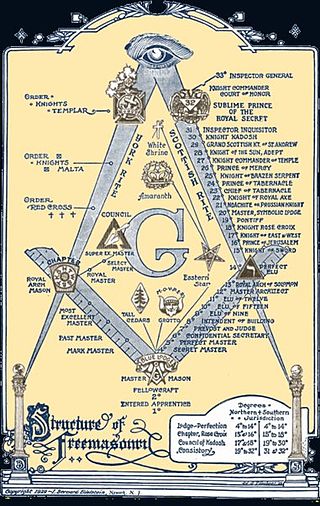
Freemasonry or simply Masonry includes various fraternal organisations that trace their origins to the local guilds of stonemasons that, from the end of the 14th century, regulated the qualifications of stonemasons and their interaction with authorities and clients. Freemasonry is the oldest fraternity in the world and among the oldest continued organizations in history.

The Ancient and Accepted Scottish Rite of Freemasonry is a rite within the broader context of Freemasonry. It is the most widely practiced Rite in the world. In some parts of the world, and in the Droit Humain, it is a concordant body and oversees all degrees from the 1st to 33rd degrees, while in other areas, a Supreme Council oversees the 4th to 33rd degrees.

A Masonic lodge, also called a private lodge or constituent lodge, is the basic organisational unit of Freemasonry.
The history of Freemasonry encompasses the origins, evolution and defining events of the fraternal organisation known as Freemasonry. It covers three phases. Firstly, the emergence of organised lodges of operative masons during the Middle Ages, then the admission of lay members as "accepted" or "speculative" masons, and finally the evolution of purely speculative lodges, and the emergence of Grand Lodges to govern them. The watershed in this process is generally taken to be the formation of the first Grand Lodge in London in 1717. The two difficulties facing historians are the paucity of written material, even down to the 19th century, and the misinformation generated by masons and non-masons alike from the earliest years.

The Knights Templar, full name The United Religious, Military and Masonic Orders of the Temple and of St John of Jerusalem, Palestine, Rhodes and Malta, is a fraternal order affiliated with Freemasonry. Unlike the initial degrees conferred in a regular Masonic Lodge, which only require a belief in a Supreme Being regardless of religious affiliation, the Knights Templar is one of several additional Masonic Orders in which membership is open only to Freemasons who profess a belief in Christianity. One of the obligations entrants to the order are required to declare is to protect and defend the Christian faith. The word "United" in its full title indicates that more than one historical tradition and more than one actual order are jointly controlled within this system. The individual orders 'united' within this system are principally the Knights of the Temple, the Knights of Malta, the Knights of St Paul, and only within the York Rite, the Knights of the Red Cross.

Lodge Mother Kilwinning is a Masonic Lodge in Kilwinning, Scotland, under the auspices of the Grand Lodge of Scotland. It is number 0 on the Roll, and is reputed by some to be the oldest Lodge not only in Scotland, but the world. There is no existing evidence to support this claim however. It is styled The Mother Lodge of Scotland attributing its origins to the 12th Century, and is often called Mother Kilwinning.

There are many organisations and orders which form part of the widespread fraternity of Freemasonry, each having its own structure and terminology. Collectively these may be referred to as Masonic bodies, Masonic orders, Concordant bodies or appendant bodies of Freemasonry.
There are a number of masonic manuscripts that are important in the study of the emergence of Freemasonry. Most numerous are the Old Charges or Constitutions. These documents outlined a "history" of masonry, tracing its origins to a biblical or classical root, followed by the regulations of the organisation, and the responsibilities of its different grades. More rare are old hand-written copies of ritual, affording a limited understanding of early masonic rites. All of those which pre-date the formation of Grand Lodges are found in Scotland and Ireland, and show such similarity that the Irish rituals are usually assumed to be of Scottish origin. The earliest Minutes of lodges formed before the first Grand Lodge are also located in Scotland. Early records of the first Grand Lodge in 1717 allow an elementary understanding of the immediate pre-Grand Lodge era and some insight into the personalities and events that shaped early-18th-century Freemasonry in Britain.
Freemasonry in Denmark was first established in 1743 and is today represented by a number of Grand Lodges. The oldest and biggest Masonic Grand Lodge in Denmark is the Danish Order of Freemasons, in English also known as the Grand Lodge of Denmark.

The Rectified Scottish Rite historically known under the RER acronyme, also known as the Rectified Rite or rarely RSR, is a Christian Masonic rite with a long and complex history. It was founded in 1778 at the Convent of Lyon in France under the leadership of Jean-Baptiste Willermoz, who served as the primary architect and driving force behind its formation. It emerged as a reform and restructuring of the earlier Templar Strict Observance system that had spread in Germany and France in the mid-18th century.
Tracing boards are painted or printed illustrations depicting the various emblems and symbols of Freemasonry. They can be used as teaching aids during the lectures that follow each of the Masonic Degrees, when an experienced member explains the various concepts of Freemasonry to new members. They can also be used by experienced members as reminders of the concepts they learned as they went through the ceremonies of the different masonic degrees.

Masonic ritual is the scripted words and actions that are spoken or performed during the degree work in a Masonic lodge. Masonic symbolism is that which is used to illustrate the principles which Freemasonry espouses. Masonic ritual has appeared in a number of contexts within literature including in "The Man Who Would Be King", by Rudyard Kipling, and War and Peace, by Leo Tolstoy.

Within the context of Freemasonry, the Chamber of Reflection, often abbreviated as C.O.R., and alternatively known as the Room of Reflection, Reflection Cabinet, or Meditation Cabinet, plays a pivotal role in the initiation process. This chamber serves as a dedicated space where a critical component of the initiation ritual unfolds, prompting the candidate to undergo a period of isolation designed to foster introspection and self-examination. The experience within the Chamber of Reflection is enriched by the presence of symbolic objects and thought-provoking phrases, which may exhibit minor variations across different Masonic rites and traditions.
Freemasonry in Scotland in lodges chartered by the Grand Lodge of Scotland comprises the Scottish Masonic Constitution as regular Masonic jurisdiction for the majority of freemasons in Scotland. There are also lodges operating under the Scottish Masonic Constitution in countries outside of Scotland. Many of these are countries linked to Scotland and the United Kingdom through the Commonwealth of Nations and prior colonies and other settlements of the British Empire although there are several lodges in countries such as Lebanon, Belgium, Chile and Peru, which do not have such connections.

The Lectures of the Three Degrees in Craft Masonry is a series of manuals on Freemasonry that are arranged in the form of catechisms to be memorized. They cover rituals and symbolism associated with the three degrees of Craft Freemasonry in question and answer form. During the second half of the 19th century, the Lectures gradually ceased to be used regularly in English Lodges.
Operative Masonry or The Worshipful Society of Free Masons, Rough Masons, Wallers, Slaters, Paviors, Plaisterers and Bricklayers or simply The Operatives is a fraternal guild claiming a history of hundreds of years over which customs, traditions, knowledge and practices were developed and handed down. It is an invitation only, Masonic society dedicated to preserving the history, rituals, and traditions of medieval operative stonemasons guilds in England and Europe that were the precursors to modern speculative Freemasonry.

In Freemasonry, the first three Masonic degrees constitute the fundamental degrees in all Rites they are called Blue Lodge of Craft degree.
Masonic myths occupy a central place in Freemasonry. Derived from founding texts or various biblical legends, they are present in all Masonic rites and ranks. Using conceptual parables, they can serve Freemasons as sources of knowledge and reflection, where history often vies with fiction. They revolve mainly around the legendary stories of the construction of Solomon's temple, the death of its architect Hiram, and chivalry. Some of the original mythical themes are still part, to a greater or lesser extent and explicitly, of the symbols that make up the corpus and history of speculative Freemasonry. Some myths, however, have had no real posterity, but can still be found in some high grades, or in the symbolism of some rituals. Others borrow from the medieval imagination or from religious mysticism, and do not bother with historical truths to create legendary filiations with vanished guilds or orders.
The Old Charges is the name given to a collection of approximately one hundred and thirty documents written between the 14th and 18th centuries. Most of these documents were initially in manuscript form and later engraved or printed, all originating from England or Scotland. These documents describe the duties and functioning of masons' and builders' guilds, as well as the mythical history of the craft's creation. It is within these fundamental texts, particularly the Regius poem (1390), also known as the Halliwell manuscript, and the Cooke manuscript (1410) for England, as well as the Schaw Statutes (1598) and the Edinburgh manuscript (1696) for Scotland, that speculative Freemasonry draws its sources. However, from a historical perspective, it does not claim a direct lineage with the operative lodges of that era.
The Adonhiramite Rite is a Masonic system consisting of 33 grades or degrees, The founding of the Adonhiramite Rite is traditionally attributed to Louis Guillerman Saint-Victor, a French Freemason who, in 1781, published the first significant work on the rite, entitled "Recueil Précieux de la Maçonnerie Adonhiramite". This rite combines Templar, Rosicrucian and other esoteric influences into a unique Masonic structure.











